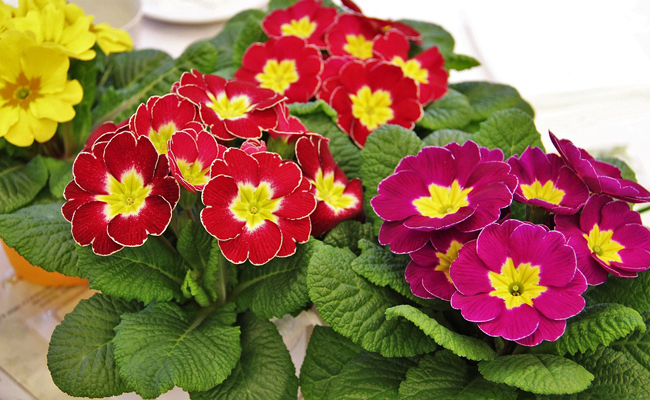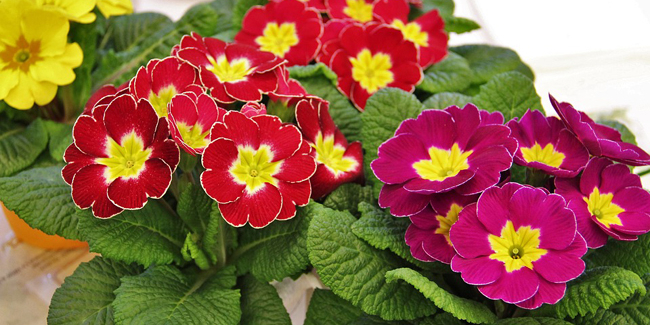The primrose (Primula spp.), whose name comes from the Latin primal which means “first”, because it is among the first flowers of spring, is a perennial herbaceous plant, 20 cm high on average, often grown as a biennial. It is quite hardy (-10°C) and its foliage is semi-evergreen.

Its roots of great density include fascicles. Its oval leaves, more or less wide, are quite thick, often wavy, embossed, even lobed, with a sensation of down to the touch. In the middle of a rosette of leaves emerge inflorescences in umbels or clusters, often carried by an erect floral stem. The often flattened, sometimes tubular, campanulate or funnel-shaped flowers have the spreading petals fused at the base into a tube. They offer a wide variety of colors ranging from white to blue through pink, lilac, red, orange, yellow, with different borders and shades.
Primrose has a light fragrance. Young primrose leaves are edible. The flowers can be used to decorate salads. Primroses are particularly decorative plants and above all they show their colors in spring: at the end of winter, their arrival is a rather good sign!
- Family : Primulaceae
-
Kind : biennial grown perennial -
Origin : Europe -
Flower color: pink, yellow, red, purple, white, blue, orange -
Sowing: Yes -
Cutting: No -
Planting: autumn winter -
Bloom : February to May - Height : 15 to 30cm
Ideal soil and exposure for planting primrose in the garden
The primrose needs fertile, fresh, humus-rich and well-drained soil, with a tendency to acid, and a light but not burning exposure, rather in partial shade.
Date of sowing, planting and dividing primroses
Sowing is done in a terrine, in a warm place (15-18°C), between May and August. When the seedlings are formed, about 1 month to 1 month and a half after sowing, transplant them into a box, keeping 5-6cm between each one. Wait another month before repotting them in individual buckets that you will place in a sheltered place outside.
Planting in soil amended with organic fertilizer (manure) is done from September to March, at a rate of 6 to 8 feet/m². Do not bury them too deeply to avoid excess moisture.
A division of large clumps can be done in the fall. Allowing primroses to naturalize is a good solution when grown on a lawn, embankment, etc.
Council of maintenance and culture of the primrose
Water in case of drought, but avoid that the soil is waterlogged or poorly drained which could be fatal.
Remove faded flowers and yellowed or damaged leaves.
Diseases, pests and parasites of primrose
Gray rot (botrytis) favored by a substrate that is too compact and excessively humid is the main fear for the primrose.
Aphids, spider mites and slugs can hamper the plant’s growth, but without major damage.
Location and favorable association of primrose
The primrose finds its place in the garden in beds, lawns, undergrowth, at the foot of trees, at the water’s edge, in rockery, on an embankment, or of course in a planter or pot.
Recommended species and varieties of Primula for planting in the garden
There are more than 400 species of the genus Primula which are organized into different botanical sections of which only a few concern gardeners. The section Polynathus includes species with broad, spreading, obovate leaves, with saucer-shaped flowers, solitary or united in bouquets or umbels. Garden Primrose (Primula x acaulis), hybrid of Primula vulgaris And primula juliae with embossed foliage, develops its solitary flowers from February to April, in all the possible colors offered by innumerable cultivars.
The hybrids of Primula eliator are very close to the garden primrose but are distinguished by a slightly higher height (30cm). There is also a wide variety of colors.
The Cuckoo (Primula veris) with pale yellow flowers that grows by the side of the road can be naturalized in a lawn: it is undoubtedly the best known species of primrose!
